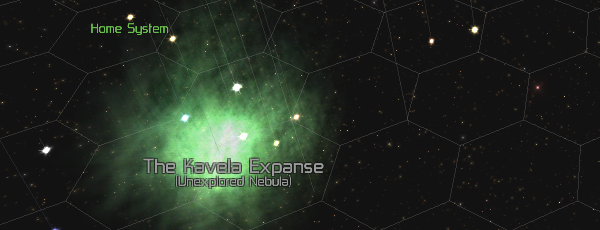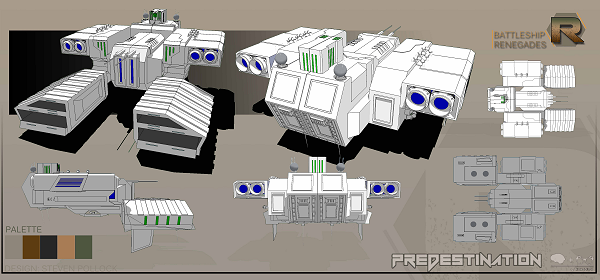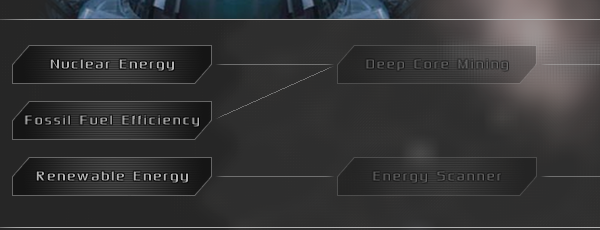We’d like to apologise for the delay in getting this month’s development update together, there’s been a lot of development progress made this month and we’ve also been buried under a mountain of paperwork! We’ve now implemented the research system, temporal rifts, nebula effects on the galaxy map, shipyards, ship crews, colony blueprints, the renewable energy scanner, and over 40 functional technologies! We’ve also got concept art blockouts completed for the ships that will be in the game, which are broken down into blocks for the 3D Ship Designer, and our 3D modelers are still working away on getting new buildings complete.
Some of this month’s work has taken a lot longer than anticipated to complete, unfortunately, and we’ve had quite a bit of bureaucracy to deal with this month on the business side of Brain and Nerd that has detracted from development time. As a result, our original release schedule aiming for release at the end of March or start of April has had to be revised. We want to put this game in your hands as much as you want to play it, but we need to do this right and can’t release the game until it’s ready.
To keep everyone in the loop and manage expectations properly, we’d like to show you the revised timeline that we’re currently aiming for. Please keep in mind that these are estimates and shouldn’t be treated as solid release dates. Brain and Nerd is a tiny indie studio working with a small budget and only two programmers, so unexpected delays may occur. If everything goes to plan and there are no unexpected problems, the new projected schedule is as follows:
- March – Galaxy Beta V1:– A focused test of the early game progression, with galaxy-level exploration, empire growth using colony blueprints, the research system (with two eras of research), shipyards (with a few pre-designed ships), and hopefully the early game tutorial. We’re working very hard to get this complete and in beta testers’ hands as soon as is physically possible.
- Early April – Galaxy Beta V2:– A second iteration on the galaxy beta, incorporating beta tester feedback from V1. This iteration will also feature Fleet Combat integrated into the galaxy-level gameplay, temporal rifts (which spawn random events and enemies to fight), and the 3D ship designer will be functional and integrated. We’ll also be implementing the research queue, research synergies, most of the main menu interfaces, and the Start Game screen for sandbox mode with various galaxy options.
- April – Ship Designer Beta V1:– A standalone version of the 3D ship designer will be released to beta backers along with all of the cosmetic parts for at least one race.
- April – Final Beta:– Feedback from Galaxy Beta V2 will be integrated into the game for our final beta test stage. If we don’t manage to implement diplomacy and the galaxy-level AI in Galaxy Beta V2, it will be added in this stage. We’ll begin heavily optimising the game’s performance and include low-graphics settings for as much of the game as we can. At this point, we’ll aim to make sure the game can run smoothly on old desktop PCs and laptops with integrated graphics chipsets.
- April / May – Early Access / Soft-Release:– Feedback from the Final Beta stage will be integrated into the game to produce an Early Access version on Steam and Desura (DRM-free) for all pre-order customers. This could come as early as April if the feedback on the final beta is promising.
- May – Iteration:– In May and beyond, we will continue to gather your feedback via our forums and iterate on the Early Access version until it’s ready for full release. Any promised features that we can’t get in before this point will be added later as free updates.
We have a lot of new stuff to show you this month, and we’d love to hear your thoughts and ideas on it. Check out the information below and then head over to the February Dev Update feedback thread on the forum to let us know what you think.
Galaxy Nebulae:

There are now five different types of nebula in the galaxy: Red, Blue, Green, Purple, and Orange. Each nebula has a name and contains several star systems close together, and stars inside nebulae roll additional random effects such as increased ore deposits, higher chance of rolling Terran planets, ancient ruins etc. Our goal is to make nebulae strategically valuable positions to hold, but also make them more difficult to defend. Space monsters may periodically attack ships and planets inside nebulae, temporal rifts might open more frequently in their vicinity, and certain technologies like shields or beam weapons may not function at all. The stars inside Nebulae are also obscured by the gas and dust until you either research Nebula Sensors or send an exploration ship to scan it.
Temporal Rifts:

We’ve now completed the first iteration of our temporal rift mechanic. Throughout the game, these rifts will open and deposit ships and materials into the galaxy or cause random effects to happen. You can send ships to investigate a rift, and something will happen when it opens. They can release enemy ships that will attack, friendly ships that will join your empire, or even deadly Revenant ships that will travel to the nearest habitable world and attack. Alternatively, you could get lucky and find wreckage that you can salvage for materials and technology, or rare commanders that will offer to work for whoever rescues them.
Since rifts are disruptions in spacetime, they can also have some pretty crazy effects on the ships you send there or nearby star systems; Ship crews could be trapped in a time loop and emerge with bonus experience, star systems could be temporarily frozen, or planets could be accelerated in time by several turns. If you have any ideas for other effects and events you’d like to see tied to Temporal Rifts, please head over to the feedback thread and let us know!
Geothermal Vents and Solar Hotspots:

Every race starts the game with one ore deposit, one coal deposit, and one food resource in range of its first colony. Terran planets will have some more coal that you can find, and some planets have a deposit of uranium to run a nuclear power plant with. If you decide to go down the fossil fuel route, there are technologies you can research to increase coal power plant efficiency and the Deep Core Mining technology will unlock additional hidden deposits of coal and uranium on every habitable planet.
If you go down the renewable energy route, you’ll unlock solar and geothermal power plants that require no resources to function but output significantly less power. To even the odds, several Geothermal Vents are now distributed randomly throughout each planet, and colonies built on these vents will enjoy a bonus to power generation from geothermal power plants. You can also research the Energy Scanner technology, which shows areas of high solar activity near the equator that do the same for solar power plants.
It’s our hope that players will strategically place their cities in these locations when colonising the planet. Based on feedback from the Planetary Exploration beta and to make strategic decisions like this more meaningful, we’ve decided to impose a limit on the number of cities a planet can have based on its size. The smallest planet type will hold only two cities, while the largest can support up to 12. These changes will be part of the upcoming Galaxy Beta and we’re looking forward to getting some feedback on how it works out.
The Research System:
The Research system has now been completed (larger image), and over 40 technologies have been designed. Technologies are separated into the four fields Physics, Construction, Bio/Chemistry, and Sociology. Each field contains branching choices that force the player to make strategic tradeoffs, as most races have to take a single path through each tech tree. Creative races will be able to go back and research alternate paths. Every technology contains one or more buildings, weapons, ship modules, or global effects (such as unlocking deep core coal and uranium deposits or the renewable energy map).
Research is divided into several self-contained technology eras themed around the various stages of the game, starting with rebuilding your civilization after crash-landing on your first planet, and moving on to space exploration, colonisation, territorial conflict, and so on. Our aim is to make it so that your race’s research progression roughly matches up with your empire’s expansion, so you’ll typically reach things like weapons around the same time you meet another race. We’re also thinking of making it so that each tech era must be unlocked with an empire achievement, so the second era might be locked until you successfully send a scout ship to another star system, the third unlocked when you make first contact with another race, etc.
Ship Design Progress:

Work is progressing on the designs for each race in our modular ship designer. The image above is a blockout of the standard Renegade battleship design. This design breaks apart into a series of hull blocks, cosmetic parts, engines, and ship modules for use with the 3D ship designer, and the smaller Renegade Cruiser and Frigate designs are both built out of the same parts. We’ll have an artwork post on the way soon with hi-res versions of the Renegade ship concepts, and the diplomacy backgrounds for each of the races revealed.









